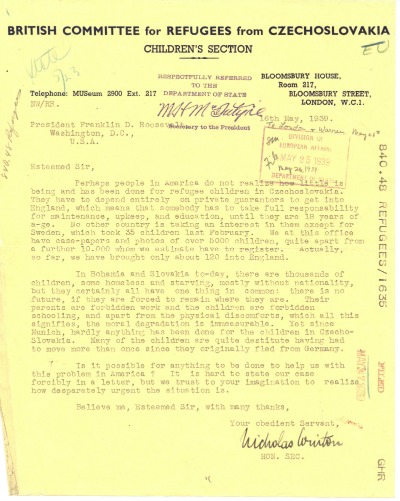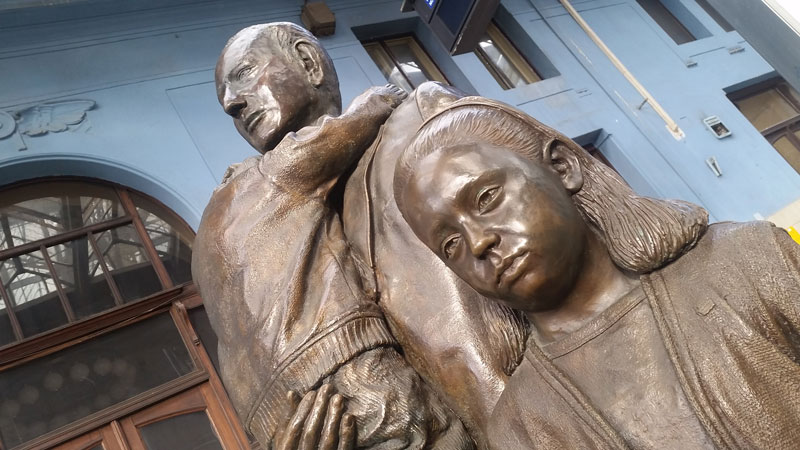The Story of Winton’s Children
Nicholas Winton, 1939
There is a difference between passive and active good. The latter, in my opinion, means to dedicate time and energy to mitigate pain and suffering. It requires one actively seeks those that suffer and are in danger; not just to live an exemplary passive life without doing evil.

The Background
Following the Munich Agreement, German soldiers marched into Czechoslovakia on October 1st 1938 and this was followed in November 1938 by the “Kristallnacht” and it’s violent attacks on the German and Austrian Jewish communities. By December 1938 with more than 150,000 displaced, the “Kindertransport” (rescue of German and Austrian Jewish Children) had begun but, the Jewish children from Czechoslovakia were not included in this rescue.
In December 1938, when 29 year old London stockbroker Nicholas Winton cancelled a two week skiing holiday to visit a friend in Prague, he could not have known about what would happen in the next 9 months and the effect that would have on the rest of his life. The friend that he visited was Martin Blake and he worked for the “British Committee for Refugees from Czechoslovakia”. During that break he visited the camps of the displaced Czechs, 150,000 people many of whom were children and many of them were Jewish. It was clear to him that the Germans would soon occupy the whole country and after that the fate of the Jewish children would be sealed. He set up a small operation that allowed parents to register their children for transport to England so by the time he left Prague before the Christmas of 1938 he had a list of hundreds of names.
Looking for Help

The British Government stipulated that any Czech children they helped had to be 1) under 18, 2) have a British sponsor and 3) pay a £50 deposit for their “return trip”. Nicholas Winton was back in London again using his friends, volunteers and even his own mother in an operation looking for sponsors and raising money. The sponsor was hugely important because without them, no documentation could be prepared so he advertised in newspapers, published photographs of Czech children and put messages in churches and synagogues. It was not just the British side he appealed to either as pictured you can see the original letter sent to U.S. President Roosevelt dated 16th May 1939. Note that the “British Committee for Refugees From Czechoslovakia” was a real organisation, Winton basically added “Children’s Section” underneath to make it look more official.
As usual, a combination of denial and bureaucracy slowed things down to the point that he turned to forgery to make many identification cards for the children.
The Transports
The first 20 children were transported on March 14th 1939. The route was simple. Leave the Prague Main Station, travel overland through Germany and Holland, catch a ferry to England and finally a train to Liverpool Street station where the children would meet their “foster” parents. Nicholas Winton was to arrange seven of these transports and in the process get 669 children out of Czechoslovakia, but on 1st September 1939 with the eighth and largest transport ready to leave the station, Germany invaded Poland. All German controlled borders (which meant Germany and Austria) were closed. It was one of Nicholas Winton’s lasting memories that because of this, 250 children were unable to leave Prague’s Main Train Station and were never heard of again. Nicholas Winton then moved on with his life, raised his family and pursued other interests.
1988
The story resurfaced in 1988 in a special episode of a TV programme called “That’s Life” when Nicholas Winton and his wife were invited as members of the audience. His wife, who had known some of the story, had come across a scrapbook that Nicholas had kept with details of the children. Unbeknown to him, the topic of the programme turned to his exploits between December 1938 and September 1939 and from the scrapbook, specifically picked out the story of one girl that he had rescued. This girl (now in her late fifties) then revealed herself as the woman sitting next to him in the audience. Then when asked who else in the audience owed their life to Nicholas Winton, everybody in the first three rows stood up.
The Memorial
One of the lesser known memorials in Prague is a statue of Nicholas Winton and two children standing on platform 1 of the Prague Main Station. Nicholas Winton never actually set foot in the Prague Train Station and much of the more dangerous work was done locally by another unsung hero, Trevor Chadwick. The statue faces west and you could be forgiven for thinking that this is a strong reference to the last train and the fate of the 250 children.

Winton’s Children
Already a national hero to the Czechs (they nominated him for the Nobel Peace Prize in 2008 and awarded him their highest civilian honour “the order of the White Lion” on his 105th birthday), the story of Nicholas Winton went global when the US programme “60 Minutes” picked it up in 2013. Of all the videos on YouTube that describe his exploits, their 15 minute programme is my favourite (you would not believe that when interviewed in this programme he was already 104 years old). Nicholas Winton was knighted in 2003 and died in 2015. Of course, those 669 children went on to have families of their own who went on to have families of their own so at the time of writing, there are more than 15,000 of Winton’s Children.
Records AND Research
Here you can find a complete List of Winton’s Children i.e. the 669 rescued. What fascinated me with this is that during research for a particular family I stumbled across Suzanne Marburg who was rescued but died along with her sponsor in an air raid on December 11th 1940. Read the actual entry at http://www.nicholaswinton.com/WintonsList/images/list15b.gif but it clearly shows that he was keeping track of the children.
This story is part of the World War Two Prague walking tour where I show you the memorial pictured and others at the train station.
The “60 Minutes” program can be viewed at https://www.youtube.com/watch?v=c0aoifNziKQ (make sure that you watch all of it).
You can also read a personal account by Alfred Dubs, one of those 669 children http://radio.cz/en/section/one-on-one/winton-child-lord-alfred-dubs-i-was-luckier-than-most-i-was-met-by-my-father-in-the-uk.
Listen to two of the Winton children aged 88 and 94 at the time of recording. They were on the last train out and spent the rest of their lives in England. One of them is Lady Milena Grenfell-Baines who was largely responsible for the “Farewell Memorial” at Prague’s Main Train Station and appears in the 60 minutes program listed earlier. Listen to the short 15 minute interview from 2024.
Something Related or a Few Minutes Away
History/WW2 – Protectorate of Bohemia and Moravia
Stolpersteine Memorial Project
Jewish Prague – Jubilee Synagogue
